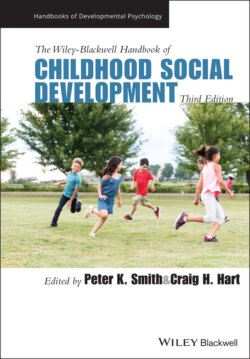Читать книгу The Wiley-Blackwell Handbook of Childhood Social Development - Группа авторов - Страница 75
Do Parents Matter? Judith Rich Harris and the Nurture Assumption
ОглавлениеWhile Del Giudice builds in the importance of peers to his model of children’s social developmental pathway, another developmentalist, also influenced by evolutionary theory, took this one step further. In 1995 Judith Rich Harris proposed that the main socializing agents during a child’s development are the genes the child inherits and the child’s peer group. This left little or no room for parental influence. This astonishing proposal was based, in part, on reports by behavioral geneticists that around 50% of the variability between children can be accounted for by genetic differences between them and between 0 to 10% by differences due to the shared parental environment (Plomin & Daniels, 1987, see also Plomin, 2018). Such findings are based on studies of individuals who vary in genetic relatedness such as twins (identical and fraternal), siblings, and step‐siblings who are either raised in the same household or in a different one. By studying various correlational scores on a range of tests between such groupings of children, behavioral geneticists found that, in terms of personality, siblings reared apart are no more different to each other than siblings reared together. In contrast, adopted siblings are no more similar to each other than to anybody chosen at random from the general populace. If 50% of the variance is accounted for by shared genes and 0–10% by shared parental environment then, Harris asked, where was the missing 40–50% variance?
In her 1995 article she suggested that the missing variance can be traced back to peer‐group relationships. Drawing on a knowledge of human evolution and the behavior of current forager societies, Harris suggested it made sense to gravitate towards the norms and social mores of a child’s peer group rather than those of the parents because children have different (and often competing) interests to parents. It is not always in the child’s best interest to learn what parents want them to learn. Rather, it pays them to adopt the social norms of their peer group as these are the individuals that will become their allies, competitors, and eventually mating partners.
Because she considers children of school age are socialized largely by their peer group, Harris called this the group socialization (GS) theory. She later brought this theory to wider public attention via her books, The Nurture Assumption (1998, 2009) and No Two Alike (2006). From the outset, Harris’s GS theory split the field. While most evolutionary psychologists were positive about her theory, including the prominent Harvard psycholinguist Steven Pinker (who incorporated her ideas into his book the Blank Slate, 2002), many developmentalists were unconvinced. Deborah Vandell (2000), for one, has suggested that, in focusing on peer groups, Harris ignores sibling and teacher influences on a child’s social development. She also queries the fact that Harris appears to assume all relations between a child and its parents’ behavior can be considered the result of either direct genetic factors or of gene–environment correlations (meaning that this variance can all be traced back to shared genes). Vandell suggests instead that Harris should have considered the possibility of a parent’s behavior influencing the child’s development independently of the genes they share. Another developmentalist who has reservations about Harris’s GS theory is Craig Hart. Alongside other criticisms, Hart (2007) suggests that parents influence what children do outside the home, which might thereby diminish Harris’s argument for peer group socialization. He is also critical of Harris’s claim that many parent‐to‐child influences on social development might, in reality, be child‐to‐parent influences, citing research that suggests bidirectional parent–child interactions. We might also ask, does her GS theory contradict Bowlby and Ainsworth’s view that early mother–infant attachment strongly influences later social behavior?
Today, Harris’s GS theory continues to divide developmentalists (Harris & Workman, 2016; Pinker 2020). Despite the apparent hardline stance of protagonists on either side of the debate, Belsky has suggested a possible synthesis between the two camps. In 2005, he argued that children vary in their susceptibility to parental influence and this, in itself, might be considered an adaptation. He suggested that, under some environmental conditions, being more susceptible to parental influence might be adaptive whereas under other conditions being influenced by peers might also be adaptive. Parental influence may work well when the environment is stable because their ways of doing things will continue to lead to success. When, however, the environment is changeable, then it pays offspring to shift to new strategies, often advocated by peers, rather than sticking with “outdated” parental ways of doing things. Belsky also points out that ancestral environments are likely often to have been a combination of these two extremes with perhaps long periods of stability being interspersed with periods of rapid change. That being the case, selection pressures would most likely favor having children who vary in their susceptibility to parental influence. If Belsky is correct, then this might eventually lead to some sort of compromise on the GS debate.
